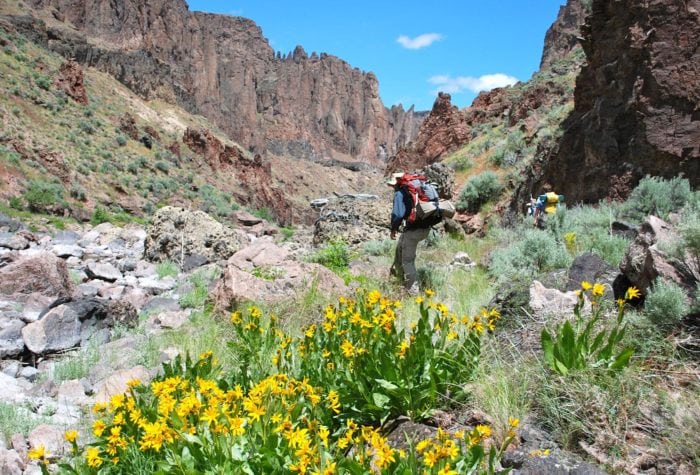Plan ahead
The Owyhee basin is predominantly fed by snowpack, which can mean an inconsistent river season each year. Typically, paddlers want to visit the Owyhee when the river is flowing at 1,000 – 6,000 CFS (cubic feet per second), which frequently means trips in mid-March through May.
Understanding the different classes of river rapids is also critical to planning a trip. The lower Owyhee River from Rome to Birch Creek is mostly flat but features about a dozen named class III rapids and two class IV rapids, depending on river levels. Whistling Bird and Montgomery are the class IV rapids, both of which can be easily scouted but only Whistling Bird is easily portaged. If you are a more experienced boater, you can consider paddling the middle Owyhee River from Three Forks to Rome for more class IV rapids and the typically portaged Class V+ Widowmaker Rapid.
Car shuttles are another consideration to plan for since the road to Birch Creek is extremely challenging and requires a high clearance vehicle with sturdy tires due to a steep, narrow road and multiple stream crossings. The standard take-out for the lower Owyhee is at Birch Creek to avoid paddling flatwater on the Owyhee Reservoir to get to Leslie Gulch. You can also hire a shuttle service to pick you up at Birch Creek and bring you back to your cars left at the Rome launch site.
To follow permit regulations, you’ll need to bring a camp toilet, frequently called a groover. This camp toilet is one of many requirements for a river trip, including a fire pan if you wish to sit around an evening campfire. Be sure to follow Leave No Trace principles and check for fire restrictions before heading out.
Once you’re there
During years with strong river levels like 2019, the Owyhee is more crowded than usual. To respect other groups, pick your campsite with consideration for your group size. The largest groups are 20 people, so if you only have a few friends with you, choose a smaller campsite and leave larger areas open for big groups.
Hikes are accessible from different campsites along the way and can be a highlight of the trip, but you won’t find trails easily marked. Look for footpaths from Hike-out, Pruitt’s Castle, Lambert Dome, and Pothole camps as a start. Don’t skip the hot springs, where some paths along the river might lead you!
Look out for Native American cultural sites along the way, including petroglyphs carved into boulders, and be sure to take only photos and leave all artifacts where you found them.
